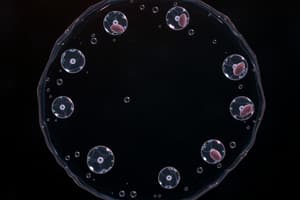Podcast
Questions and Answers
What is the function of the proteins that bind to the centromeric DNA?
What is the function of the proteins that bind to the centromeric DNA?
What is the outcome of the separation of sister chromatids during mitosis?
What is the outcome of the separation of sister chromatids during mitosis?
What is the term used to describe the narrow region of the duplicated chromosome?
What is the term used to describe the narrow region of the duplicated chromosome?
What process follows mitosis in the cell division cycle?
What process follows mitosis in the cell division cycle?
Signup and view all the answers
What is the resulting chromosome number in daughter cells produced by meiosis?
What is the resulting chromosome number in daughter cells produced by meiosis?
Signup and view all the answers
What is the purpose of mitosis and cytokinesis in multicellular organisms?
What is the purpose of mitosis and cytokinesis in multicellular organisms?
Signup and view all the answers
What is the main purpose of meiosis in the human body?
What is the main purpose of meiosis in the human body?
Signup and view all the answers
What is the primary function of the mitotic phase in the cell cycle?
What is the primary function of the mitotic phase in the cell cycle?
Signup and view all the answers
What percentage of the cell cycle is typically accounted for by interphase?
What percentage of the cell cycle is typically accounted for by interphase?
Signup and view all the answers
What was the significance of Walther Flemming's discovery in 1882?
What was the significance of Walther Flemming's discovery in 1882?
Signup and view all the answers
What is the duration of the mitotic phase compared to interphase?
What is the duration of the mitotic phase compared to interphase?
Signup and view all the answers
What occurs during the G1 phase of interphase?
What occurs during the G1 phase of interphase?
Signup and view all the answers
During which phase of interphase does the duplication of chromosomes occur?
During which phase of interphase does the duplication of chromosomes occur?
Signup and view all the answers
What is the approximate duration of the M phase in a 24-hour cell cycle?
What is the approximate duration of the M phase in a 24-hour cell cycle?
Signup and view all the answers
What is the primary function of the mitotic spindle?
What is the primary function of the mitotic spindle?
Signup and view all the answers
Which phase is the most variable in length in different types of cells?
Which phase is the most variable in length in different types of cells?
Signup and view all the answers
What is the purpose of the G0 phase?
What is the purpose of the G0 phase?
Signup and view all the answers
What happens to the cell after completing the M phase?
What happens to the cell after completing the M phase?
Signup and view all the answers
Study Notes
- Meiosis in humans occurs exclusively in the ovaries or testes, reducing the chromosome number from 46 to 23, and fertilization restores the number to 46.
- Mitosis conserves the chromosome number in every somatic cell nucleus of a new individual, and it alternates with interphase in the cell cycle.
- Walther Flemming developed dyes in 1882 to observe chromosomes during mitosis and cytokinesis, and he coined the terms mitosis and chromatin.
- Interphase accounts for about 90% of the cell cycle and consists of three phases: G1, S, and G2, during which intense metabolic activity and growth occur.
- The G1 phase involves cell growth, the S phase involves chromosome duplication, and the G2 phase involves preparation for cell division.
- The mitotic phase, which includes mitosis and cytokinesis, is usually the shortest part of the cell cycle, and it is followed by cytokinesis.
- Chromosomes are duplicated during the S phase, and each new nucleus receives a collection of chromosomes identical to that of the parent cell.
- Mitosis yields daughter cells with the same number of chromosomes as the parent cell, whereas meiosis yields daughter cells with half as many chromosomes.
- Cytokinesis completes the mitotic phase, and it is the division of the cytoplasm that follows mitosis.
- The cell cycle consists of growth, duplication of chromosomes, preparation for cell division, and cell division itself, and it can be repeated in daughter cells.
- The duration of each phase varies among different types of cells, with the S phase taking around 10-12 hours and the G2 phase taking around 4-6 hours in a 24-hour cycle.
- Mitosis is divided into five stages: prophase, prometaphase, metaphase, anaphase, and telophase, and the mitotic spindle forms during prophase.
Studying That Suits You
Use AI to generate personalized quizzes and flashcards to suit your learning preferences.
Description
Learn about meiosis in humans, its role in generating gametes, and its relationship with mitosis in the cell cycle. Understand how meiosis reduces the chromosome number and how fertilization restores it. Discover the importance of meiosis in human reproduction.




